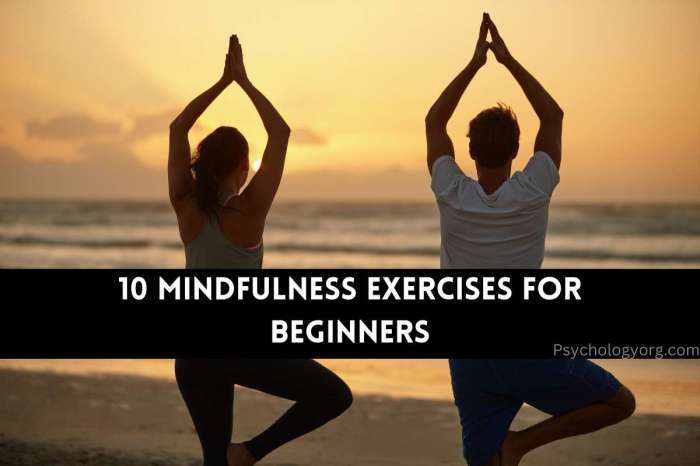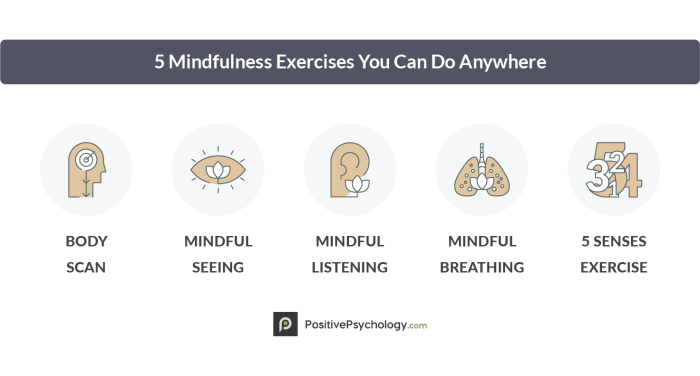Mindfulness Exercises: Get ready to dive into a world of relaxation and mental clarity with this ultimate guide to mindfulness exercises. From meditation to breathing techniques, we’ve got you covered with all you need to know!
Introduction to Mindfulness Exercises

Mindfulness exercises are activities or techniques that help individuals focus on the present moment and cultivate awareness of their thoughts, feelings, and surroundings without judgment.
Practicing mindfulness exercises has numerous benefits, including reducing stress, improving focus and concentration, enhancing emotional regulation, and promoting overall mental well-being.
Popular Mindfulness Exercises
- Body Scan: A practice where individuals focus on each part of their body, from head to toe, to bring awareness to physical sensations and release tension.
- Deep Breathing: Involves taking slow, deep breaths to calm the mind and body, promoting relaxation and reducing stress.
- Mindful Walking: Walking slowly and deliberately, paying attention to each step and the sensations of movement, to increase awareness and grounding in the present moment.
- Loving-Kindness Meditation: A practice that involves sending well-wishes and compassion to oneself and others, fostering feelings of empathy, connection, and positivity.
Mindfulness Meditation: Mindfulness Exercises

Mindfulness meditation is a practice that involves focusing your mind on the present moment and being fully aware of your thoughts, feelings, sensations, and surroundings without judgment. It aims to help you develop a sense of calm, clarity, and emotional balance.
Principles of Mindfulness Meditation
- Find a quiet and comfortable place to sit or lie down.
- Close your eyes and take deep breaths, focusing on the sensation of the air entering and leaving your body.
- Bring your awareness to your thoughts and feelings without getting attached to them or trying to change them.
- Notice any physical sensations in your body, such as tension or discomfort, and simply observe them without reacting.
- Practice being present in the moment and accepting things as they are, without judgment or resistance.
Impact of Mindfulness Meditation on Mental Well-being
- Mindfulness meditation has been shown to reduce stress, anxiety, and symptoms of depression.
- It can improve focus, attention, and cognitive function, leading to better decision-making and problem-solving skills.
- Regular practice of mindfulness meditation can enhance self-awareness and emotional regulation, promoting overall mental well-being.
- Studies have also suggested that mindfulness meditation may help increase feelings of compassion, empathy, and gratitude towards oneself and others.
Breathing Exercises
Breathing exercises are an essential component of mindfulness practice, helping to ground individuals in the present moment and promote relaxation. These exercises can range from simple diaphragmatic breathing to more structured techniques like box breathing. By incorporating breathing exercises into daily routines, individuals can experience a range of physiological and psychological benefits.
Diaphragmatic Breathing
Diaphragmatic breathing, also known as deep belly breathing, involves taking deep breaths that expand the diaphragm. This type of breathing can help reduce stress and anxiety by activating the body’s relaxation response. To practice diaphragmatic breathing, find a comfortable seated position and place one hand on your chest and the other on your belly. Inhale deeply through your nose, allowing your belly to rise, and exhale slowly through your mouth, feeling your belly fall.
Box Breathing, Mindfulness Exercises
Box breathing is a structured breathing technique that involves inhaling, holding the breath, exhaling, and holding the breath again in a pattern resembling a square or box. This technique can help regulate the nervous system and promote a sense of calm. To practice box breathing, inhale deeply for a count of four, hold the breath for a count of four, exhale for a count of four, and hold the breath again for a count of four. Repeat this cycle several times.
Benefits of Breathing Exercises
– Physiological benefits: Breathing exercises can help lower blood pressure, improve circulation, and boost the immune system.
– Psychological benefits: By focusing on the breath, individuals can reduce anxiety, increase mindfulness, and improve concentration.
– Incorporating Breathing Exercises into Daily Routines: To make breathing exercises a habit, try incorporating them into your morning routine, taking a few minutes to practice deep breathing before starting your day. You can also use breathing exercises as a way to unwind before bed or during moments of stress throughout the day.
Body Scan Techniques
Body scan techniques are a fundamental aspect of mindfulness practice, allowing individuals to bring attention to different parts of the body to cultivate awareness and relaxation.
The process of body scanning involves systematically focusing on various body parts, from head to toe or vice versa, noticing any sensations, tension, or areas of discomfort. The purpose of body scanning is to develop a deeper connection between the mind and body, promoting relaxation, stress reduction, and self-awareness.
How to Perform a Body Scan Effectively
- Find a comfortable position, either sitting or lying down, and close your eyes.
- Start by bringing your attention to your breath, taking a few deep inhales and exhales to center yourself.
- Slowly shift your focus to different body parts, such as the feet, legs, abdomen, chest, arms, and head, scanning for any sensations without judgment.
- Notice any areas of tension or discomfort, and try to breathe into those areas, allowing them to relax and release.
- Continue moving through each body part, spending a few moments on each, and observing the sensations present.
- Once you have scanned through the entire body, take a few more deep breaths and slowly open your eyes, returning to the present moment.
Mindful Walking
Mindful walking is a form of mindfulness practice that involves bringing your full attention to the act of walking. It is about being present in the moment, focusing on each step, and being aware of your surroundings. This practice can help cultivate a sense of calm and relaxation while also increasing awareness of your body and surroundings.
Steps to Practice Mindful Walking
- Start by finding a quiet place to walk, either indoors or outdoors.
- Stand still for a moment and take a few deep breaths to center yourself.
- Begin walking at a slow, deliberate pace, paying attention to each step you take.
- Notice the sensation of your feet touching the ground, the movement of your legs, and the swaying of your arms.
- Stay present and focused on the physical sensations of walking, letting go of any distractions or thoughts.
- If your mind starts to wander, gently bring your focus back to the act of walking.
- Continue walking mindfully for a few minutes, or as long as you feel comfortable.
Benefits of Mindful Walking
- Improves concentration and focus by training the mind to stay present.
- Reduces stress and anxiety by promoting relaxation and grounding in the present moment.
- Enhances awareness of body sensations and movements, fostering a deeper connection to the physical self.
- Encourages a sense of gratitude and appreciation for the simple act of walking and being alive.
- Can be easily incorporated into daily routines as a form of active meditation.
Visualization Exercises
Visualization is a powerful technique used in mindfulness practices to enhance relaxation, reduce stress, and improve focus. By creating mental images, individuals can tap into their imagination and create a sense of calm and clarity.
Examples of Visualization Exercises
- Imagine yourself in a peaceful garden, surrounded by blooming flowers and a gentle breeze. Take deep breaths and feel the sense of tranquility wash over you.
- Visualize a calming ocean scene, with waves gently crashing on the shore. Feel the warmth of the sun on your skin and the sound of seagulls overhead.
- Picture yourself floating on a cloud, weightless and free. Allow yourself to let go of any worries or tension as you drift through the sky.
How Visualization Enhances Mindfulness and Focus
Visualization can enhance mindfulness by engaging the senses and promoting a deeper connection to the present moment. By vividly imagining calming scenes or scenarios, individuals can anchor themselves in the now and cultivate a sense of peace and awareness. This heightened focus on the visualization helps to quiet the mind and reduce distractions, allowing for a more profound mindfulness experience.





